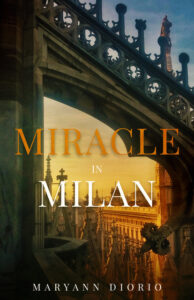By MaryAnn Diorio, @DrMaryAnnDiorio
Most of us are familiar with the expression “Location! Location! Location!” when it comes to the value of real estate. Regardless of other important features in determining the worth of a home, location is the key factor.
When it comes to writing fiction, the key factor is “Emotion! Emotion! Emotion!” It is emotion—not plot or characterization or dialogue—that ultimately determines the worth of a story to a reader. This is not to say that plot, characterization, and dialogue are not important. But, ultimately, emotion is what carries the story—and the reader.
Studies have shown that, popular opinion to the contrary, we humans make decisions based on emotion. Subconsciously, it is emotion that drives us. When we are torn between reason and emotion, emotion invariably wins the day.
You may have noticed that all advertising appeals to and targets the emotions. Most copywriters appeal to fear, greed, and lust when creating their copy. They know that if you can lasso the consumer’s fears and fleshly desires, you have him.
While we, as Christ-Followers, certainly do not employ unethical methods when writing our stories, we do, nonetheless, target the emotions. Readers read for the emotional impact of a story. When they come to a novel, they are looking to feel. And to feel above all!
So, how do you make your reader “feel” your story? Here are a few proven techniques:
1. Write in Deep POV. Deep POV is the technique of enabling your reader to become your character. When you write in deep POV, your reader experiences life from inside the character. He lives the story through your character’s body, mind, and heart. This intimacy provides your reader with a satisfying experience whereby he discovers that, just as the character overcomes, he also can overcome.
As novelist Randy Ingermanson points out in his outstanding book, How to Write a Dynamite Scene Using the Snowflake Method, “Story is a safe way to face danger” (Ingermanson 9). Readers subconsciously read fiction to overcome fears and to solve problems. As Ingermanson further observes, “Story is what happens when you walk through great danger in somebody else’s skin” (ibid.). Deep POV enables your reader to walk through conflict and danger—whether physical, emotional, or relational—in your character’s skin.

2. Show; don’t tell. We novelists have heard this dictum countless times, yet obeying it makes for stories that are powerful in their emotional impact. But what does it mean to show and not tell?
Showing your story instead of telling it means to relate your story through sensory details and actions rather than through exposition. When we show our story to the reader, we utilize all five senses. As in deep POV, when we practice showing instead of telling, we enter the skin of the character and become the character.
A simple way of understanding showing vs. telling is to say that showing illustrates or creates a picture while telling simply states a fact.
Here is an example of each:
TELLING: Michael was angry.
SHOWING: Michael clenched his fists and pressed them hard into his sides. His breath came in short gasps. If Jason said one more word, Michael would clock him.
Show the reader the emotion your character is feeling. Playwright Anton Chekhov beautifully describes the difference between showing and telling in his famous quote: “Don’t tell me the moon is shining. Show me the glint of light on broken glass.”
3. Be specific in choosing your words to express emotion. Use strong verbs. Avoid clichés. Create original metaphors. Dig deep into your own heart and draw out the emotions connected to the experiences you have had. For example, you may never have experienced the fear of living in a war-ravaged country, but you have experienced fear.
As poet William Wordsworth advised, “Fill your paper with the breathings of your heart.” When you do, your reader will be reading your pages with the breathings of her heart. And when that happens, your reader and your character will have become one.
_________________________________________________________________________
Copyright 2022 by MaryAnn Diorio, PhD. All Rights Reserved.
Source Cited: Ingermanson, Randy. How to Write a Dynamite Scene Using the Snowflake Method. Ingermanson Communications, Inc., 2018.
When a young, female auditor discovers evidence that the man she loves is an embezzler, she must choose between ruining him or ruining herself.Chief Auditor for New York City-based Enson Pharmaceuticals is assigned to audit the books of Enson’s Italian branch in the romantic city of Milan, Italy. Having made an inner vow never to trust a man again because of her father’s betrayal, Amy finds herself falling in love with Enson Italia’s American-born Vice-President, Ted McMasters. Will Ted be the one to cause her to break her inner vow?Ted McMasters is on the run. A run from rejection. From himself. From God. Having been wounded by a father who made him feel worthless, and having been dumped by the woman he wanted to marry, Ted is determined to keep all women at bay. But will Amy Torelli be the reason he changes his mind?
MaryAnn Diorio writes women’s fiction from a small, quaint, Victorian town in southern New Jersey where neighbors still stop to chat while walking their dogs, houses still sport wide, wrap-around front porches, and the charming downtown still finds kids licking lollipops and old married folks holding hands. A true Jersey girl, MaryAnn is a big fan of Jersey diners, Jersey tomatoes, and the Jersey shore.



